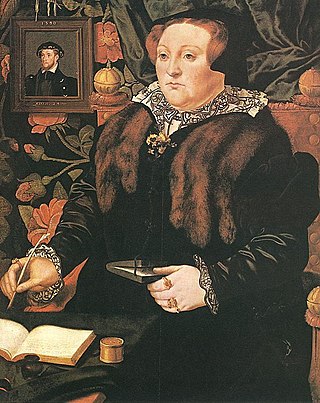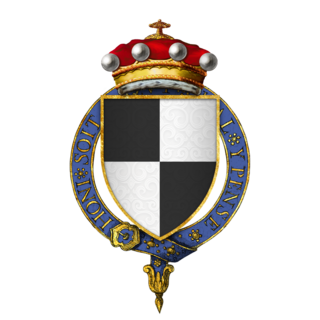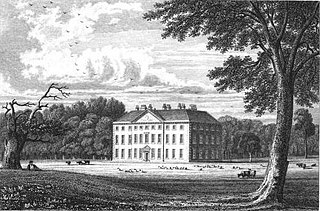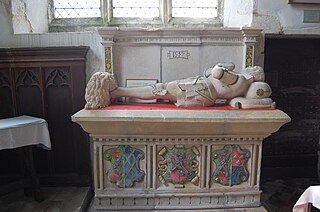
Baron Dacre is a title that has been created three times in the Peerage of England, every time by writ.

Baron Saye and Sele is a title in the Peerage of England held by the Twisleton-Wykeham-Fiennes family. The title dates to 1447 but it was recreated in 1603. Confusion over the details of the 15th-century title has led to conflicting order for titleholders; authorities such as Burke's Peerage and Debrett's Peerage do not agree on whether or not the 1447 creation is still extant.
Henry Norris was an English courtier who was Groom of the Stool in the privy chamber of King Henry VIII. While a close servant of the King, he also supported the faction in court led by Queen Anne Boleyn, and when Anne fell out of favour, he was among those accused of treason and adultery with her. He was found guilty and executed, together with the Queen's brother, George Boleyn, Sir Francis Weston, William Brereton and Mark Smeaton. Most historical authorities argue that the accusations were untrue and part of a plot to get rid of Anne.

Baron FitzHugh, of Ravensworth in North Yorkshire, is an abeyant title in the Peerage of England. It was created in 1321 for Sir Henry FitzHugh. The title passed through the male line until the death in 1513 of George FitzHugh, 7th Baron FitzHugh, when it became abeyant between his great-aunts Alice, Lady Fiennes and Elizabeth, Lady Parr, and to their descendants living today, listed below. The family seat was Ravensworth Castle in North Yorkshire, situated 4.5 miles north-west of Richmond Castle, caput of the Honour of Richmond, one of the most important fiefdoms in Norman England.

Mary Fiennes, Baroness Dacre was the daughter of George Neville, 5th Baron Bergavenny by his third wife, Lady Mary Stafford, youngest daughter of Edward Stafford, 3rd Duke of Buckingham.

Thomas Hoo, Baron Hoo and Hastings KG was an English courtier. William Camden called him vir egregius, literally an "outstanding man".
Richard Fiennes, jure uxoris 7th Baron Dacre was an English knight and hereditary keeper of Herstmonceux Castle, Sussex.
Joan Dacre, 7th Baroness Dacre was a suo jure peeress of England. She was born in Gilsland, the daughter of Sir Thomas Dacre (1410–1448) and Elizabeth Bowett.

Freckenham is a small rural village and civil parish in the West Suffolk district of Suffolk in East Anglia, in the country of England.

Thomas Fiennes, 8th Baron Dacre was an English peer and soldier, the son of Sir John Fiennes.

Margaret Fiennes, 11th Baroness Dacre was a suo jure peeress having been created Baroness Dacre by King James I of England in 1604. She was the daughter of Thomas Fiennes, 9th Baron Dacre who was executed for murder in the year of her birth. His title and lands had been forfeited to the crown. Baroness Margaret's husband was Sampson Lennard MP.

John Clench was an English judge, a Serjeant-at-Law, Baron of the Exchequer and Justice of the Queen's Bench, of the late Tudor period. He established his family in south-east Suffolk, in the neighbourhood of Ipswich, where for many years he was the Town Recorder.

Sir Stephen Soame was an English merchant, landowner and politician who sat in the House of Commons in 1601. He served as Lord Mayor of London for the year 1598 to 1599.
Francis Brewster was an English politician who sat in the House of Commons in 1653 and 1656.

Robert Brewster (1599–1663) was an English landowner of Parliamentarian sympathies who sat in the House of Commons at various times between 1645 and 1659.

Sir Robert Brooke was an English landowner, magistrate, commissioner, administrator and MP who sat in the House of Commons between 1624 and 1629. He made his country seat at Cockfield Hall, Yoxford, Suffolk.

Benacre Hall is a Grade II listed country house and estate in Benacre, Suffolk. The current house is high Georgian, with Palladian geometric influence and figures externally roughly as it stood on its building, in 1764. It is the seat of the Gooch baronets.

Sir Goddard Oxenbridge, KB was an English landowner and administrator from Sussex.

Sir Edward Echyngham, , of Barsham and Ipswich in Suffolk, was a commander on land and at sea, briefly Constable of Limerick Castle, and Collector of Customs at Ipswich. He is remembered as the author of a letter to Cardinal Wolsey describing the death of Lord Admiral Howard at Brest in 1513. From 1485 the presence of the Howard Dukes of Norfolk was felt directly along the Barsham reach of the River Waveney from their possession of Bungay Castle.
Thomas Thursby (1487–1543) of Ashwicken was a notorious land encloser in Norfolk in the 1510s–1540s.















